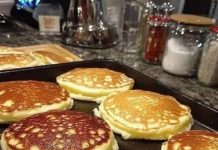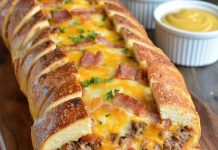There’s something incredibly satisfying about baking fresh bread at home. However, the thought of kneading dough for long periods can be daunting, especially for beginner bakers. If you crave the warm, comforting aroma of homemade bread without the hassle of extensive preparation, this no knead bread recipe is just what you need.
With only four basic ingredients and a hands-off approach, you can create a rustic loaf with a crisp crust and tender crumb. This recipe is ideal for those who want to enjoy freshly baked bread with minimal effort.
Ingredients
- 3 cups bread flour or all-purpose flour: Choose either bread flour for a chewier texture or all-purpose flour for a lighter, softer loaf.
- 1/2 teaspoon instant yeast: Instant yeast is preferred for its ease of use and quick activation.
- 1 1/2 teaspoons sea salt: Sea salt enhances the flavor and strengthens the dough.
- 1 1/2 cups warm water (110°F): Warm water helps activate the yeast, creating the perfect rise.
Instructions
- Prepare the DoughBegin by combining the flour, yeast, and sea salt in a large mixing bowl. Whisk these dry ingredients together to ensure they are evenly distributed. Gradually add the warm water while stirring with a wooden spoon. Continue to stir until the mixture forms a sticky, loose dough. It’s okay if the dough seems a bit messy; that’s normal for no knead bread. Cover the bowl tightly with plastic wrap and leave it on the counter to rise for 12 to 18 hours. This long rise time allows the dough to develop its flavor and texture without any need for kneading.
- Shape the DoughAfter the dough has risen, it will be bubbly and have a slightly shaggy appearance. Transfer the dough to a well-floured large piece of parchment paper. Sprinkle a bit of flour on top of the dough to prevent sticking. Using the parchment paper, gently shape the dough into a rough ball. It doesn’t need to be perfectly shaped—imperfections are part of its rustic charm. Remember, this is a no knead bread, so no need to knead the dough.
- Second RiseOnce shaped, cover the dough with plastic wrap, a lightly moistened tea towel, or an upside-down glass bowl. Let it rise for another hour. This second rise will help the bread become lighter and airier. Meanwhile, place a large Dutch oven (about 3.5 quarts) with its lid on into the oven and preheat it to 450°F.
- Bake the BreadWhen the dough has finished its second rise, carefully remove the hot Dutch oven from the oven. Be cautious as both the pot and lid will be extremely hot. Remove the lid and, using the parchment paper, transfer the dough into the pot. Replace the lid and bake the bread for 30 minutes.After 30 minutes, remove the lid to allow the bread to develop a golden brown crust. Continue baking for an additional 10 to 15 minutes, or until the crust is beautifully golden and crisp. Using the parchment paper, carefully lift the bread out of the Dutch oven and transfer it to a cooling rack.
- CoolingFor the best texture and flavor, let the bread cool for at least 1 to 2 hours before slicing. Although it’s tempting to cut into warm bread, allowing it to cool helps to set the crumb and enhance the flavor.
Notes
- Rising Time: The dough needs 12 to 18 hours to rise, so plan accordingly. If you need to slow down the rising process, you can refrigerate the dough. Dough rises approximately ten times slower in the fridge compared to room temperature.
- Second Rise: While the second rise is optional, it contributes to a lighter, airier loaf. Skipping it may result in a denser texture.
- Dutch Oven: A good-quality Dutch oven is ideal for baking bread, as it creates a consistent and even heat. If you don’t have one, any heavy, oven-safe pot with a lid will work.
- Shaping the Dough: Don’t stress about perfecting the shape of the dough. The parchment paper is a great tool for shaping and transferring the dough into the Dutch oven.
- Cooling: Letting the bread cool completely before slicing allows the crumb to set properly, giving you the best texture and flavor.
Conclusion :
This no knead bread recipe is a game-changer for those who want homemade bread without the fuss. With minimal ingredients and no need for kneading, it’s perfect for beginner bakers and anyone looking for an effortless way to enjoy fresh, crusty bread. The long rise time develops deep, rich flavors while the Dutch oven ensures a beautifully crisp crust. Whether you’re serving it with soup, making sandwiches, or simply enjoying a slice with butter, this no knead bread is sure to become a favorite in your baking repertoire. So, give it a try and savor the satisfaction of freshly baked bread with ease!
Nutrition
- Calories: 172 kcal
- Carbohydrates: 34 g
- Protein: 6 g
- Fat: 1 g
- Saturated Fat: 0.1 g
- Polyunsaturated Fat: 0.3 g
- Monounsaturated Fat: 0.1 g
- Sodium: 440 mg
- Potassium: 54 mg
- Fiber: 1 g
- Sugar: 0.1 g
- Vitamin A: 1 IU
- Vitamin C: 0.003 mg
- Calcium: 9 mg
- Iron: 0.4 mg
Enjoy the simplicity and satisfaction of baking your own no knead bread—an effortless way to fill your home with the delightful aroma of freshly baked goodness!
Source of the picture : smalltownwoman










